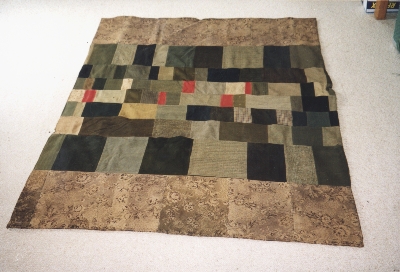Quilt No.775PB - Tricia Bowdler

1600 x 1220mm
The quilt was probably made by Alice Esther Layden and, if not, by her daughter Phyllis (King) in Victoria probably post war.
"The quilt was discovered in a dilapidared old 'back yard' caravan at Langwarrin on the Mornington peninsular by Paul King [grandson or son of the maker] and my sister Wendy Drowley. They were searching through old clothes to save them for an amateur theatre company when the quilt was 'discovered'. ��...luckily my sister knows of my involvement and love of quilts and it was saved. Apparently, a couple of others were thrown out as they had been completely destroyed by the rats and possums! Mind you they had a good 'feed' on my wagga as well. But after careful dry cleaning it has come up beautifully and the holes and nibble are a testimony to a long and useful life."
[Tricia Bowdler 14.12.2000
"Alice Esther Layden was born 14 October 1885 in Yorkshire, England and died in Sydney on 18 March 1974, aged 88 years.
Her parents were Sarah Ann Thorpe (an upstairs maid, born 9 April 1868 in Derbyshire) and William Layden (a coal miner, born 16 July 1864, also in Derbyshire).
In 1888 she sailed to Australia with her parents and younger sister, Norah (born 1887) where they settled in a small cottage at Scarborough in Bulli Shire, NSW.
Her parents had eleven more children after arriving in Australia - three sons and eight daughters - William (1899), Alfred (1908),Edward (1912) and Clara (1890), Hannah (1892), Hattie (1894). Annie (1897), Isabel (1901), Emily (1904), Gladys (1905) and Sarah (1910) - to bring the number of offspring to 13����
In 1908 Alice Lester Layden married George Silas Casey (born 7 April 1880), when she was 23 and they lived in a number of Sydney suburbs until they eventually moved to Penshurst, a suburb to the south of Sydney.
They had one daughter when they lived in Moore Park - Phyllis Marjory - who was born 23 February 1910. Although Phyllis was an only child she had four children of her own (Ronald, Paul, Fay and Simon) by Percy James King (born Sydney 1888), who she married in 1946.
In the mid 1950s Phyllis and Percy, together with the three youngest of her four children (Ronald had migrated to Canada by this time), moved to Victoria in a metal caravan in which they lived for a brief period at Chelsea Caravan Park before moving to a 3/4 acre block of land at Langwarrin, three miles east of Frankston. Purchased for 1000 pounds, the land became the eventual home of the family, who lived in a number of outbuildings without running water, electricity or sewerage until the early 1960s. They were pioneers in what was (at the time) bushland, until the outlying areas of Frankston spread to a new suburb, Karingal, and then on to Langwarrin.
Phyllis was widowed in 1964 and in 1974, after her mother's death, she went back to Sydney to settle the estate, returning to Langwarrin with her mother's belongings and furniture. She stored some of the clothing and other items in the old caravan and it was here that the quilt was discovered after Phyllis's death in July 2000.
While living in Melbourne, at a number of places, including George Street, Fitzroy, Phyllis worked as a dress maker in Richmond and Collingwood and eventually dressmaking was her main means of employment at Langwarrin, where she had a large clientele eager to acquire stylish quality clothing.
It is not clear who actually made the quilt, although as it was found in the caravan it is likely that Alice was the maker. However, depending upon its date of creation, it could be that Phyllis produced it."
[Paul R. King (son)]
Related Quilts:
2200 x 1720 mm.
1170 x 920mm
840 x 840mm
2360 x 2230 mm
1625 x 925mm
1800 x 1800mm






